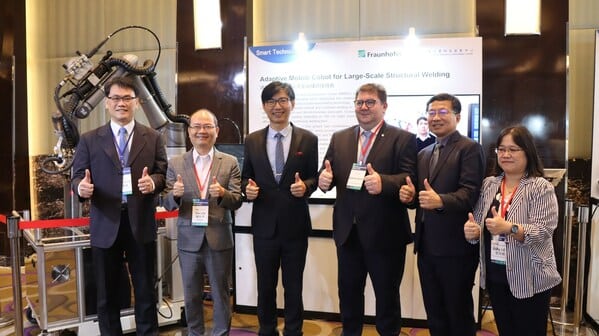KAOHSIUNG, April 3, 2024 /PRNewswire/ — RTOs International Network (RIN), an entity within the European Association of Research and Technology Organizations (EARTO), Europe’s premier network of R&D institutions, convened its inaugural meeting in Taiwan this year. Chiou Chyou-Huey, Director General of the Department of Industrial Technology at the Ministry of Economic Affairs (MOEA), together with the chief executives of RIN member organizations and delegates from various R&D institutions, assembled at the Grand Hyatt Taipei on March 27th for the 2024 RIN Summit with Taiwan RTOs. The gathering aimed to bolster and broaden engagement with Taiwan’s R&D community. With the backing of the MOEA’s Department of Industrial Technology, the Metal Industries Research & Development Centre (MIRDC) joined forces with Germany’s Fraunhofer IPA and National Research Council Canada (NRC) to showcase their exceptional collaborative achievements at the Summit. MIRDC exhibited its leading-edge technology and expertise in industrialization, with focus on overcoming challenges faced by local industries and facilitating their access to global markets.
MIRDC and Fraunhofer have collaborated to develop the first “Miniaturized Welding Cobot” to overcome the challenges associated with automating the welding of large structural steel components. Featured in the photo, from left are Cheng-Chang Chiu, Director at MIRDC, Yung-Hsiang Lai, President of MIRDC, Chyou-Huey Chiou, Director General of the Department of Industrial Technology at the MOEA, Mathias Rauch. Director of the Research Strategy and Policy Department at the Fraunhofer-Gesellschaft, Meng-Tsung Su ITRI senior vice president and RIN chair, Yueh-Hsiu Lee, Director at MIRDC.
Advancing Welding Techniques and Embracing Human-Robot Synergy
Historically, the task of welding large ship hulls has always been highly complex. It involves not just the joining of two metal plates, but also the intricate fusion of flat and curved surfaces, requiring a range of welding positions such as flat, vertical, and overhead. Mastering these techniques to ensure quality welding at a rapid pace has been a significant challenge for welders on-site. As a result, they must undergo extensive training and secure relevant certifications before being assigned to such tasks. However, human physical strength and focus have their limits. To address this issue, help workers reduce fatigue, and improve the quality of welds, MIRDC, by leveraging the respective expertise of Fraunhofer IPA, CSBC Corporation, and Techman Robot Inc., has developed the first miniaturized welding collaborative robot (or cobot). This innovative solution aids in overcoming the challenges associated with automating the welding of large structural steel components.
The newly developed welding cobot is not only user-friendly and highly mobile but also comes equipped with laser scanning sensors that emulate the eyes of a skilled welder. These sensors can capture the 3D profile of each weld bead in real time, adapting to changes in the bead shape and thermal input. By generating reference coordinates and multi-layer profiles rapidly, the robot digitizes the expertise of a master welder, creating a database of parameters that allow the robotic arm to execute each weld with precision and high quality, with the weld length extended from the original 30 cm to 100 cm. This advancement has not only optimized the welding process but also enhanced welding efficiency by over 90%. Following a year of concept and feasibility testing, the technology is now set to be deployed in larger-scale fields. Looking forward, the cobot is poised for integration into a broader range of industrial applications, such as high-rise construction, petrochemical operations, and offshore wind power generation. This integration is anticipated to significantly boost industrial capacity.
Transforming Sewage Sludge into Clean Energy
In addition, MIRDC has advanced the technology for electrochemical methane production through the joint development of liquefied waste biomass sources with NRC. Although Taiwan’s biomass energy sector has not thrived, largely due to limited variety and the number of available material sources, Taiwan produces 760 million metric tons of sewage sludge annually. Furthermore, this output is increasing at an annual rate of over 20%, providing a reliable source of biomass materials.
Working in collaboration with NRC, MIRDC leveraged organic sludge as a biomass source. By applying hydrothermal liquefaction, which generates high temperatures and pressures, the team successfully broke down the complex biomass molecules into simpler ones. The process has significantly increased the efficiency of methane production, boosting the gas yield from 40% to 75% and reducing the reaction time by over 30%. This progress has shortened the traditional anaerobic fermentation period from 30 days to less than 7 days, greatly enhancing methane production efficiency. Currently, with the field validation provided by wastewater treatment facilities, organic sludge is treated through a high-pressure hydrothermal liquefaction process to promote biodegradation, followed by anaerobic fermentation that reduces the volume of sludge and transforms wastewater into renewable resources. Looking ahead, MIRDC plans to forge stronger connections with equipment providers and further develop technologies to maximize the benefits of a green economy and sustainable ecosystem.
Yung-Hsiang Lai, President of MIRDC, stated that the two milestones are a testament to the organization’s commitment to fostering industrial innovation and pursuing international collaboration. These achievements also showcase Taiwan’s determination to consistently advance its industrial technologies, contributing to a brighter future aligned with the broader objective of sustainability.
MIRDC and the NRC team have collaborated to employ high-pressure hydrothermal liquefaction technology to break down biomass feedstocks into small molecules, enhancing the efficiency of biomass-based gas production. Featured in the photo, from left, are Dr. Hsuan-Cheng Liu, Engineer at MIRDC; Yueh-Hsiu Lee, Director at MIRDC; Yung-Hsiang Lai, President of MIRDC; Lakshmi Krishnan, Vice President of Life Sciences at NRC; Cheng-Chang Chiu, Director at MIRDC; Cheng-Yuan Hung, Assistant Chief at MIRDC and Tao-Lin Li, Chief at MIRDC.
View original content to download multimedia: Read More
